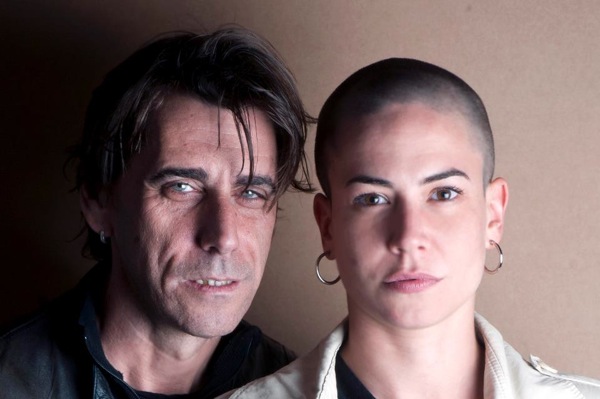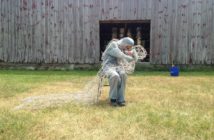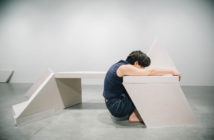| "Entering in this state allows me to increase endurance — prolonging the lasting and going into unknown territory — to discover things, situations or conditions previously unknown." |
Verena Stenke and Andrea Pagnes have been working together under the moniker of VestAndPage since 2006. "The world is our studio," as Stenke poignantly put it. The internationally traveled pair have taught in Mexico City, produced a film in Antarctica, and most recently, conducted an intensive workshop in Florence, Italy. Having a vast traditional artistic training, both Stenke and Pagnes turned to body-based work as if it was their calling medium, citing the intuition and spontaneity of performance as a true reflection of the beauty within art-making. In the following interview, VestAndPage uncovers what it's like for a performer to speak to their internal void, their way of reaching a higher state of consciousness, and how their relationship as partners shapes new meanings. They are preparing for their first Boston-based performance this upcoming weekend as part of Near Death Performance Art Experience, which they hope will allow audiences to find an "entrance" into oneness: their art, reciting the continuous cycle of life, death, and the connections in-between.

(Balada Corporal, Latin America, 2010-11. Photographs: Sérgio Prucoli, Aisha Ryannon Pagnes)
Alexis Avedisian: You both come from mixed creative backgrounds: Verena, trained in dance and martial arts and Andrea in painting and glass sculpture. How have these histories influenced your work as body-based artists?
Andrea Pagnes: What you mention is a part of the disciplines we have worked with in the past. Personally I’d like to add our practices in social theater, creative writings and video as crucial influences in our work, too. At a certain point of my life’s path, the necessity of not using any other classical support but my body only came up as a natural consequence, to inscribe on the living flesh so to say. And this necessity to express my life’s path in an objective way lead me to find in Performance art the most appropriate way to express all my artistic concerns. Meeting with Verena implemented the range of possibilities, due to a continuous fruitful dialogue between myself and "the other part of me." I think this is the same for her. Plus, by this encounter we reached an expressiveness: learning through the different backgrounds of one another; culturally, artistically and spiritually.
Verena Stenke: Our current work surely comes as a natural consequence of our past experiences and trainings, and have influenced to a certain degree the topics we work with and the techniques in which we conceive, execute and present. We have grown in the last year, and are still extending our branches in different directions for attaining a variety of perspectives. We continue to question the limits and limitations of fixed schemes and boxes, as it’s in the interferences and reciprocal influences that we find the possibility for positive spherical contamination and infections. At one point, what we were doing became labeled as "Performance art," though we did not make the decision to do performance art one day. We were just naturally following a path. However we may call it, this way of working gives us the possibility to free our creativity, and to use what is most appropriate for expressing a thought or conducting a research. We both felt as if classical supports and schemes were far too limiting. With all the love we nurture for the arts and theatre, for what we need to speak about there is not enough space within these boxes. For speaking about beauty and life, there is much a need of authenticity, intuition and spontaneity.
AA: Have these pasts further developed your relationship to methodology in your work?
AP: There is a common invisible thread that unites what we see as apparently different disciplines, a thread that merges along with the process of making and conceiving. The constant training we have been pursuing is constituted by elements of the different disciplines we have touched and explored before, and that in the praxis of performance are tools we can use, depending on the nature of each project.
VS: Our methodology is based on associative processes instead of fixed conceptual orders. There is a huge amount of ‘organicity’, or responsiveness, maybe also because of our various backgrounds and because we always work in two. Through the process of creating, we experiment a lot by working from all sides: we add and subtract, inspire and re-create, finally condensing into extracting the essence of that which we circulate around in a project. There is not "your idea / my idea" - we start instead from one vision, the next adds something to it, the other takes something off, and by the end results something that can be called neither a product of Andrea nor product of mine. By approaching a work in its process through flexibility instead of following a fixed scheme brings us to new insights and is a surprising and enriching process.

(Fear is Fear. Love is Love., 24-hour performance, Mexico City, June 2012)
AA: Your studies in methodology, "which works on memory activation and stimulation of the personal, inner library for creative use," brought together a project in Mexico City with the Alumnos47 Foundation, working with inner-city children on the topics of "fear, desire, and dreams." What was it like to gain the trust of these youth? How has working with them re-informed your practices about location and environment?
AP: There are no technical rules for experiences like this. There is no key to gaining the trust of a person, less of a Mexico City street-girl. It is through our own sense of trust, generosity and disposal that we can trigger a relationship: it’s all about love. And when I say love, it is Love with a capital L, not something to be confused with romance, sense of piety or compassion, but to make the encounter something special and unique, both for oneself and the other. Life is the art of the Encounter: this is what I believe in and the art I do. Performance art, speaks continuously about life. So you can see here the evidence in this equation.
When I position myself somewhere in location or environment, it is not that I am intellectually re-informed. I don’t have this conceptual reasoning — I am like a sponge. When I find myself somewhere, I am sucked into the place where I am. There’s the response of the place where I am within me — and it is like we are one entity — where are all intellectual barriers are dropped off, and the empathy towards this place is what makes things happen. Again it’s a question of love towards oneself and the things around you, no matter where you are, no matter who you are.
VS: The project "Fear is Fear. Love is Love." was part of our 24-hour performance commissioned by Alumnos47 for their Proyecto Liquido, in which we were invited to investigate the topic of Fear. We were thinking a lot on how to approach that subject, and were interested in finding universal notions of fears. Being with the street-girls of Yolia N.G.O. through an intensive workshop was challenging for us, and provided us with many new perspectives for the final work. As Andrea said, there are no academic or educational rules or techniques if one wants to enter the core of oneself and another, if not the ones of humbleness, respect and love. The experiences and notions of fear of these girls goes beyond my knowledge. We tried to create a common ground together with them, so we all learned how to listen to each other: as they listened to us, we listened to them, and we all learned from each other.
Environmental influences and cultural and social conditioning are facts that we can’t deny — but in the end, if we strip all this off, there remain a tear or a smile — no matter in which country, culture or condition we live or work. We are interested in reaching this core, this nucleus of the human soul and to speak about this in our works. We are not interested in making mono-cultured statements, but to find that common notions that concern each one of us around the world we live in, and the best path for this is always through humbleness and unconditional love.

(sin∞fin, video still, Antarctica, 2012)
AA: Having traveled to several countries to exhibit, where is your favorite place to work? What comes to mind when you think about this place?
AP: There is no favorite place to work for me, as first comes the quality of the project and the people involved, no matter where we are. Then of course we can have personal pleasures being in an extensive residency offering us the chance to learn more about and connect more deeply with a place or culture, which might lead to enjoy one place rather than another one. But that is just a personal taste, and not an artistic concern. Because of language or culture we might feel more ‘home’ in some places, like Latin America, because of our friends or because we speak the language. Or in places where there are specific stunning or tough environmental structures. But in the end for us the whole world is a place to be experienced, discovered and be surprised of.
VS: The world is our studio; hence the idea of favoring something is not what we feel, and not what we are searching for. We have been lucky to have the chance to work intensively in various cultures and environments, and each one has significantly influenced and enriched our work. Every step out of the comfort zone is a challenge and a growth. I too favor work well, which is not so much a matter of financial or environmental possibilities, but of the duende: the tune, motivation, vision, persistence, authenticity and professionalism behind a project and the people involved into it.
Personally, working in outstanding natural environments is something surely wonderful. Such as the work in Antarctica, which I still carry deeply within. But we wouldn’t and couldn’t work exclusively like this, as this is only one sphere of many, the one of nature. However, our work is also very much in need of and a response to the social sphere. We can work well in a variety of challenging social or environmental circumstances; but for our artistic research, all of that is inspiration. The artistic and humanistic is tightly connected; we’re not interested in art for the arts, or art of oneself, neither as a statement or for a market. Art is a true life-project for us: a philosophy or a state of mind, connected inseparably with humanity and our precarious and conflictive condition.
AA: Andrea, in Considering the Nature of the Poetic Image and it's Performativity described durational works as being "blurred into an unusual sensorial kaleidoscope, where lively images in constant motion operate like a magnifying glass, unveiling the unknown, as if it was something that has always been there." How do you reach the "higher state" in your work?
AP: By concentrating to a point where I feel I almost enter into a deep touch with my own internal Void. I say almost because I cannot be one-hundred percent sure about my deepest unknown. What I know is that I am on the way. The more I go further, the more I process to the peak. This means to gradually abandon captious judgments and criticism and to give the chance for my Self (which is not the ego) to flow as free as possible, trusting completely in sensorial perception. Entering in this state allows me to increase endurance — prolonging the lasting and going into unknown territory — to discover things, situations or conditions previously unknown to me because of my rational grid.
VS: Concentration and commitment to the action brings me into a heightening of the senses. The more I work and exercise, the more this also enters my everyday life, which increases my sensorial sensibility. Working very much on the senses, by taking one of or multiplying another one, we experience new levels of perception: something that has always been there, in which we just were to dazed to perceive. Duration helps to enter this state more easily through a time process. For me, the time is not crucial, rather the preparation and ability to enter the process that allows this state. Our preparation is continuous every day, and once we present a performance, it’s just one moment of an entire process. And once we are there, we really don’t know what we’re going to encounter.

(Without Tuition or Restraint, The Exchange Gallery, Penzance, UK, November 2011. Photo: Steve Tanner)
AA: In your 2011 performance, Without Tuition or Restraint you explore the dual topics of freedom and imprisonment. The metal cage appeared also in your 2010 performance, The Birds. What is your relationship to the cage? If your work elaborates on the bodies reaction to it's environmental context, how does being locked and forced still affect your internal or emotional state? Are these performances meditative?
AP: The cage entered into my work in 2007. It’s a symbol of a clear reclusion that can be read in different layers of meaning; physically, mentally, and spiritually. It reflects a situation that I encountered, experienced and lived through in my life. I don’t think that ‘meditative’ is the right word or idea for this because meditation implies a sort of detachment from reality. It is much more a way of reestablishing myself in that condition to activate my memories, to not forget where and what I was and am, and to trigger a cathartic process of possible liberation.
VS: For me the cage is an ambiguous element; I do not enter it in these performances, but rather circulate around it. There’s restrictiveness even in clinging to the idea of freedom. The fact that we always work as a duo, involves that we form a bipolar sphere. Being "locked and forced" can have many forms — as what exists together reciprocally influences each other, it also infects each other both positively and negatively. What we create out of this, usually under pressure, leads to something that could be yet undefined. Our works often make reference to spheres that influence each other, sometimes in form of mutual possession, or in the following relief and liberation. In all of this there is an infinite number of mechanisms, which we work to examine in our performances. All of our work is or isn’t meditative, it depends which idea one has of meditation. For us, committing ourselves completely to something is crucial, not only in art but in life as well.


(Top: La Promenade Du Sceptique, Academia di Belle Arti, Venice, Italy 2011. Photo: Andrea Moruccio. Above: The Wedding, Norogachi, Mexico, April 2010. Photo: Gustavo Alvarez)
AA: In contrast to being caged alone, you have been documented in-performance entwined together (Balada Corporal and The Wedding). The quote "A man and woman slowly approach each other, find each other, and finally trust each other blindly," was used to describe your 2011 performance La Promenade Du Sceptique, as if you were outsiders to each other. Do you approach your performances together as partners or strangers? Is this specific to the work being performed? What is it like to maintain this creative relationship for several years?
AP: The sensation I have anytime when we perform is again the possibility offered by the common ground Verena and I have chosen. Performance art is like a sublime territory where we can renovate and regenerate the ritual, our own ritual: the encounter, the union, the long goodbye and again the meeting. So then it can happen by the nature of the performance we are doing in that very moment; that by chance we find and see ourselves as two strangers who are on paths that are ready to cross, or like a couple that, to survive, has to accomplish splitting duties and responsibilities, as it is in life.
VS: Sometimes the closest partners are the biggest strangers, and strangers are partners upon meeting — Andrea and I when working are always on that thin ridge in between these states. The bi-polar sphere is a rich territory to explore, and here too, things and conditions are not fixed but in continuous transformation. We can be partners now, and with the next step strangers lingering along their own path, lost and alone though being still beside each other. Erich Kaestner’s poem Sachliche Romanze (eng: Clinical Romance), speaks about a couple:
"When they had been acquainted eight years / (and one could say they were well-acquainted), / they lost their love abruptly. / Like others lose a walking stick or a hat. […] From the window one could wave to the ships. / He said it's about quarter after four / and time to get coffee somewhere. / Nearby somebody practiced piano.[…]"
This is a significant image of relationships. We loose and find each other, and still we are part of a world that keeps turning and challenging us. We’re not interested in romance, or a romantic idea of the couple; we’re a man and a woman, and as a couple we form the smallest social sphere. In our work we’re speaking about a man and a woman, being biologic stereotypes without falling into clichés, though remaining interchangeable between each other and with others.


(Top: A Morphologic Journey (On the Boarders of Our Bodies), VESSEL Contemporary Art, Plymouth (UK), September 2011. Photos: Margaret Sharrow, Kendal Noctor. Above: SUITEnovus, Grand Hotel Minerva, Florence (IT) presented by MOMAP Museum Of Modern Art Panzano. March 2010. Photo: VestAndPage.)
AA: Your work has been described as "transfixing into an alternate state of awareness that is simultaneously terrifying and beautiful." In some of your performances, you use materials to create otherworldly, fantastical environments. You have used natural forces like fog, fire, and liquid, and tech-elements like projections and lighting. Describe this blend of natural/unnatural materials. Are (your materials) intentionally used to transition the audience into unsettled territories?
AP: I’m surely seduced by and pulled by some specific materials as if they were magnets to me. It is a need, and I don’t know where it comes from, but it is like a very clear call. I think that the first to be shifted is Verena and I, and this of course I can’t tell, but if we are shifted, the audience in response is shifted as well — transitioned into the territory opened by us. I have an inclination for using some materials which I feel they really belong to me, or are a prolonging of my constitutional being, so it is not just a use, but a dialogue that I have with them, having clearly in mind that if there is any intention, we have to reduce it to the minimum degree, because intention is our first enemy. It’s not to cope with the material; I’d rather say that we have to cope with the intention on using that material. If I have to think to the "perfect performance" to do one day, it would be when it’s clearly evident that any material is a part of my being, so one doesn’t just see a performer and a material, but a whole only.
VS: The use of materials is an organic process too. In our workshops we often exercise with the participants to enter in a mutual balance with the object — so that it is neither the artist that masters or dominates the object, nor the object that dominates the artist. When we reach this moment in which ourselves and the object listen and respond to one another, something unexpected can happen, free of intention and concept. As Andrea said, we choose our objects and materials intuitively instead of intentionally. When we start conceiving a new work, we go around attentively and pick up various inspirations, objects, materials, sounds, and images, with which we start experimenting. In a performance we try not to force a relationship with the object, but to remain flexible in response to it, so we new meanings can emerge that were not thought by us before. The same counts for materials, matter, space, time and other people.
AA: Are you conscious of the audience while performing?
AP: The human presence is the essential element in Performance art besides space, time and objects. In many works we connect and work directly with the audience.
VS: The other as viewer, the audience, is a strong, ever-changing and unpredictable energy-field: curious, skeptical, committed, receiving and giving, from which we don’t expect anything, and which often surprises us. The other is something new to discover every time, new doors to open, new arms to fall into, new eyes to watch, and new stories to listen to. The other deserves always our respect, and I say here respect as spiritual attitude. If I have to find a meaning, in our performances the audience represents a source of interchanging ethic values, aesthetics values, emotions, feelings, thoughts, moods...
 (Jamie McMurray, via Near Death Performance Art Experience)
(Jamie McMurray, via Near Death Performance Art Experience)
AA: What is your relationship to Near Death? What are you hoping the audience takes with them after your performance in Boston?
AP: We are glad to be in Boston because of the invitation extended by Vela Phelan, which together with Alice Vogler are beautiful people, artists and friends. How the project had been conceived by Vela, in an unique and special concept, we are able to test ourselves in a topic we concern. The quality and the history of the other invited artists make us curious to share the experience with them. The hope I have is that the audience can share this experience: that is not just our individual experience, but mainly the entire project itself. We are just a cell of this body that Vela Phelan and his team initiated and conceived, one which we are a part of. I hope that the audience understands this, and not just one single work. Of course we will work for taking out the best from ourselves in this project, but as performance is unpredictable, the ‘entrance’ into the experience is what counts the most. I believe that is what we will try, to enter all together as artists. And, whoever wants to take our hands is welcome to come with us.
VS: I’m thankful for the invitation by Vela to conceive a new work specifically for Near Death Performance Art Experience. The topic of death, sleep and slumber is important to the core of our work, just as are impermanence, liminal spaces and shifting states. We’re looking to wave visceral and mythical reflections on death and rebirth into the narrative of urban regeneration. We’re very much looking forward to sharing this with the other artists, the Near Death team and audience in Boston. I think it will be an intense experience for everybody, for the nature of the theme and the quality of works to be presented. Just like Andrea, I’m looking forward to the general experience that will emerge, and which the audience and everyone involved will leave with after this day. I see the Cyclorama as a perfect space in the sense of its architecture: the project tells about the cycle of life and death, and we’ll work within a round space in which artists and works are not confined to walls and corners, but along a circular path that has no beginning and no end. I think this might create a very special atmosphere, sublimely interconnecting the single works in a new way.
Boston Center for the Arts
VestAndPage will perform in Boston as part of Near Death Performance Art Experience, curated by Vela Phelan, Sunday, April 21 2013, 4pm. http://vest-and-page.de




